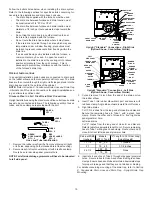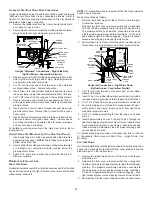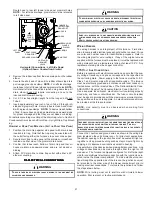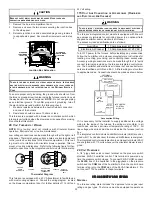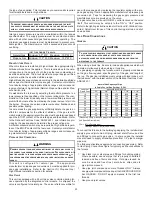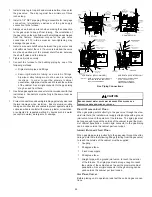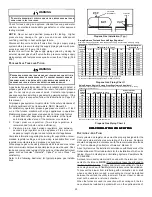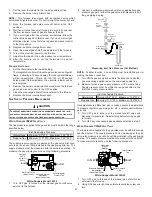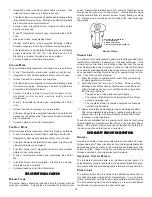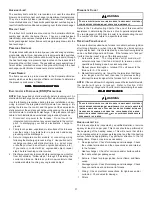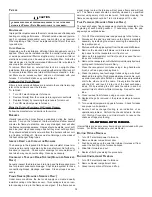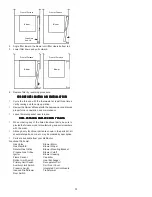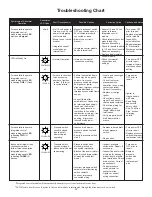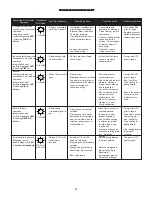
32
F
ILTERS
CAUTION
T
O ENSURE PROPER UNIT PERFORMANCE, ADHERE TO THE FILTER SIZES
GIVEN IN THE
P
RODUCT
D
ATA
B
OOK APPLICABLE TO YOUR MODEL*.
M
AINTENANCE
Improper filter maintenance is the most common cause of inadequate
heating or cooling performance. Filters should be cleaned (perma-
nent) or replaced (disposable) every two months or as required.
When replacing a filter, it must be replaced with a filter of the same
type and size.
F
ILTER
R
EMOVAL
Depending on the installation, differing filter arrangements can be
applied. Filters can be installed in either the central return register
or a side panel external filter rack (upflow only). A media air filter or
electronic air cleaner can be used as an alternate filter. Follow the
filter sizes given in the Recommended Minimum Filter size table to
ensure proper unit performance.
To remove filters from an external filter rack in an upright upflow
installation, follow the directions provided with external filter rack kit.
To remove internal filters see
Internal Filter Removal
section. Inter-
nal filters are an accessory item and are not included with your
furnace. For further details, see your distributor.
H
ORIZONTAL
U
NIT
F
ILTER
R
EMOVAL
Filters in horizontal installations are located in the central return reg-
ister or the ductwork near the furnace.
To remove:
1.
Turn OFF electrical power to furnace.
2.
Remove filter(s) from the central return register or ductwork.
3.
Replace filter(s) by reversing the procedure for removal.
4.
Turn ON electrical power to furnace.
M
EDIA
A
IR
F
ILTER
OR
E
LECTRONIC
A
IR
C
LEANER
R
EMOVAL
Follow the manufacturer’s directions for service.
B
URNERS
Visually inspect the burner flames periodically during the heating
season. Turn on the furnace at the thermostat and allow several
minutes for flames to stabilize, since any dislodged dust will alter
the flames normal appearance. Flames should be stable, quiet, soft,
and blue (dust may cause orange tips but they must not be yellow).
They should extend directly outward from the burners without curl-
ing, floating, or lifting off. Flames must not impinge on the sides of
the heat exchanger firing tubes.
I
NDUCED
D
RAFT
AND
C
IRCULATOR
B
LOWERS
The bearings in the induced draft blower and circulator blower mo-
tors are permanently lubricated by the manufacturer. No further lu-
brication is required. Check motor windings for accumulation of
dust which may cause overheating. Clean as necessary.
C
ONDENSATE
T
RAP
AND
D
RAIN
S
YSTEM
(Q
UALIFIED
S
ERVICER
O
NLY
)
Annually inspect the drain tubes, drain trap, and field-supplied drain
line for proper condensate drainage. Check drain system for hose
connection tightness, blockage, and leaks. Clean or repair as nec-
essary.
F
LAME
S
ENSOR
(Q
UALIFIED
S
ERVICER
O
NLY
)
Under some conditions, the fuel or air supply can create a nearly
invisible coating on the flame sensor. This coating acts as an insu-
lator causing a drop in the flame sense signal. If the flame sense
signal drops too low the furnace will not sense flame and will lock
out. The flame sensor should be carefully cleaned by a qualified
servicer using emery cloth or steel wool. Following cleaning, the
flame sense signal should be 1 to 4 microamps at 115 volts.
F
LUE
P
ASSAGES
(Q
UALIFIED
S
ERVICER
O
NLY
)
The heat exchanger flue passageways should be inspected at the
beginning of each heating season. If necessary, clean the pas-
sageways as outlined below.
1.
Turn OFF the electrical power and gas supply to the furnace.
2.
Disconnect the gas line and remove the burner/ manifold
assembly by removing the screws securing the assembly to
the partition panel.
3.
Disconnect the flue pipe system from the induced draft blower.
4.
Remove the induced draft blower and, drain and pressure
tap hoses from the recuperator coil front cover.
5.
Remove the recuperator coil front cover to expose the coil
tubes and turbulators.
6.
Remove the recuperator coil turbulators individually by slowly
pulling each turbulator forward firmly.
7.
Clean the recuperator coil tubes using a long handle wire
brush, such as a gun cleaning brush.
8.
Clean the primary heat exchanger tubes using a wire brush
attached to a length of high grade stainless steel cable, such
as drain cleanout cable. Attach a variable speed reversible
drill to the other end of the cable. Slowly rotate the cable
with the drill and insert it into one of the heat exchanger
tubes. While reversing the drill, work the cable in and out
several times to obtain sufficient cleaning. Repeat for each
tube.
9.
Clean residue from furnace using a vacuum cleaner.
10. Replace the parts removed in the previous steps in reverse
order.
11. Turn on electrical power and gas to furnace. Check for leaks
and proper unit operation.
12. Severe heat exchanger fouling is an indication of an
operational problem. Perform the checks listed in
Section
XIV, Startup Procedure and Adjustments
to reduce the
chances of repeated fouling.
X
X
X
X
XX. INTERNAL FIL
X. INTERNAL FIL
X. INTERNAL FIL
X. INTERNAL FIL
X. INTERNAL FILTER REM
TER REM
TER REM
TER REM
TER REMOV
OV
OV
OV
OVAL
AL
AL
AL
AL
Internal filters are an accessory item and are not included with your
furnace. For further details, see your distributor.
B
OTTOM
R
ETURN
R
EMOVAL
1.
Turn OFF electrical power to furnace.
2.
Remove blower compartment door.
3.
Push back and up on the wire filter retainer to release it from
under the front lip of the furnace basepan.
4.
Slide filter forward and out.
5.
Replace filter by reversing the procedure.
B
LOWER
C
OMPARTMENT
R
EMOVAL
1.
Turn OFF electrical power to furnace.
2.
Remove blower compartment door.
3.
Grasp lower portion of filter and lift up.


